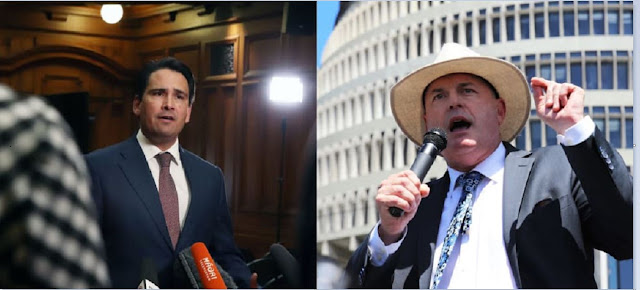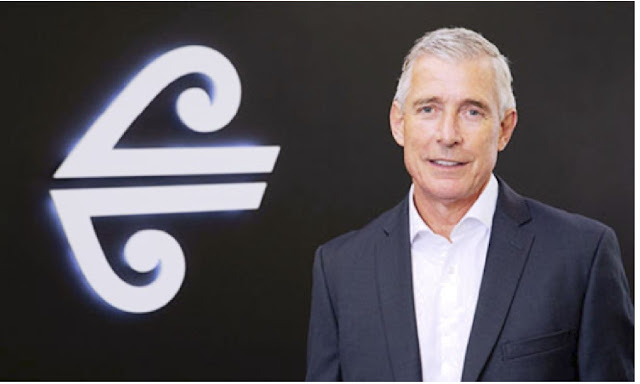THE PERSON WHO “SHOT” SIMON BRIDGES: A BRILLIANT SATIRE FROM
THE 1962 CLASSIC WESTERN
THE 1962 CLASSIC WESTERN
Steve Braunias, Senior Writer of NZ Herald pulls a masterpiece Satire from the 1962 classic Western black and white movie “The Man Who Shot Liberty Valence”, starring John Wayne, James Stewart and Lee Marvin).
 |
| Steve Braunias did a brilliant juxtaposition of the scene from "The Man Who Shot Liberty Valence" with the recent bloody leadership scrap in the National caucus room |
This satire, on demise of Simon Bridges by Todd Miller, is a brilliant satirical juxtaposition in the gunfight in the movie. Only those who have seen the movie, and older readers will get this satire, and the climax, which says a great deal without saying anything.
Please read the “diary’ below, and I will spill the bean at the end - revealing who “shot” Simon Bridges
THE DIARY [From NZ Herald, Saturday 23 May, 2020.]
xxxxxxxxxxxxxxxxxxxxxxxxxxxxxxxxxxxxxxxxxxxxxxxxxxxxxxxxxxxxxxxxxxxx
MONDAY
The main street was empty when I rode to the saloon this evening. "Easy," I said to my horse. The silence made it nervous.
The saloon was empty, too. A player piano in the corner struck up a honky tonk.
"Shot of whiskey," I said to the barman. He brought over the bottle, and poured.
"Not seen you in these parts before," he said.
"I've been coming in here every day since 2014," I said.
He studied my face. I took off my hat. He shrugged his shoulders.
I took a gulp. It burned my lungs. I said, "Why's it so quiet tonight?"
He poured himself a shot. His eyes were red. He said, "Ain't you heard? Sherriff Bridges is in a bad way. He done himself an injury. And now this whole damned town has gone to hell. Hell, I tell ya!"
He brought the bottle to his lips. I reached out and grabbed his wrist. "Mind telling me," I said in a low voice, "what happened?"
"He done shot himself in the darned foot," he said.
"Could happen to anyone," I said. "He done shot himself in both feet," he said.
I took the bottle and pulled on it. It lit a fire in my head. "Seems to me," I said, "like this town needs a new sheriff."
The music stopped playing.
 |
| The showdown in "The Man Who Shot Liberty Valence" |
TUESDAY
I called in on Miss Kaye. She was darning socks with one hand, and fixing a barn door with the other. She's always had ambition.
" I want you to run as my deputy, " I said.
She lit a cheroot, and spat on the floor. Her blonde hair shone like gold.
"The townsfolk like you," I said. "They all remember how you done taught Miss Ardern a lesson."
"Not once, but twice," she said. The memory brought a smile to her lips. She sipped her sherry, and powdered her face.
"Deputy, " she said. "Yeah. Okay. But just tell me one thing."
"Shoot."
"What did you say your name was?"
WEDNESDAY
I called in on Miss Collins. She was in her attic, wearing a white lace dress and singing to a porcelain doll in her lap.
"Get the hell out of here," she shrieked.
THURSDAY
I saw Sherriff Bridges limping down the main street. The sky was dark and a dog barked. He headed into the saloon. I went in after him. He stood at the bar and ordered a cognac. He always did have class.
"Tomorrow," he said, "at high noon."
The player piano struck up a slow ballad. I wanted to cry. The sheriff was a good man. But he'd had his time. The town needed to be saved.
FRIDAY
High noon.
The air was cool and a donkey brayed. I saw Miss Kaye's face pressed against the window of the upstairs hotel. Miss Collins was in her attic, shrieking. Miss Bennett sat on the saloon porch in her rocking chair. It creaked.
A bead of sweat rolled into my eye. My hands started shaking.
"Draw," said Sherriff Bridges.
There was a flash of silver and a puff of smoke — from behind the sheriff's back. He fell to the ground. I walked over to him.
"Todd," he said.
His voice sounded far away.
I stood up, and walked to the saloon. Miss Bennett was nowhere to be seen. The town was still deadly quiet.
"The usual," I said to the barman.
"Not seen you in these parts before," he said.
A voice came from the shadows of the bar. "Well, now. Looks like there's a new sheriff. Let me buy you that drink, pardner."
I peered into the darkness. It was Miss Ardern. SHE PUT HER GUN ON THE TABLE (My emphasis)
xxxxxxxxxxxxxxxxxxxxxxxxxxxxxxxxxxxxxxxxxxxxxxxxxxxxxxxxxxxxxxxxxxxx
In the climax of the movie, Stewart, who is novice with a gun, faces, Valence (Lee Marvin) in the draw and shoots him dead. But unbeknown to him, it was the experienced marsman and gunfighter John Wayne who shot Liberty Valence, from the shadows.
And in the dairy above, that is where Jacinda Ardern walks from darkness and puts her gun on table.
Climax:
IT WAS ARDERN WHO “SHOT” SIMON, UNBEKNOWN TO TODD.
[About the author: Steve Braunias of NZ Herald wrote the dairy above. This was a brilliant piece from him, who should get an award for this. It was for that reason that Thakur posted it here, for benefit of those who do not get to read NZ Herald, and those who have not seen the Western movie or know the plot. Thakur Ranjit Singh, is a media commentator, and runs his blog, FIJI PUNDIT]




























